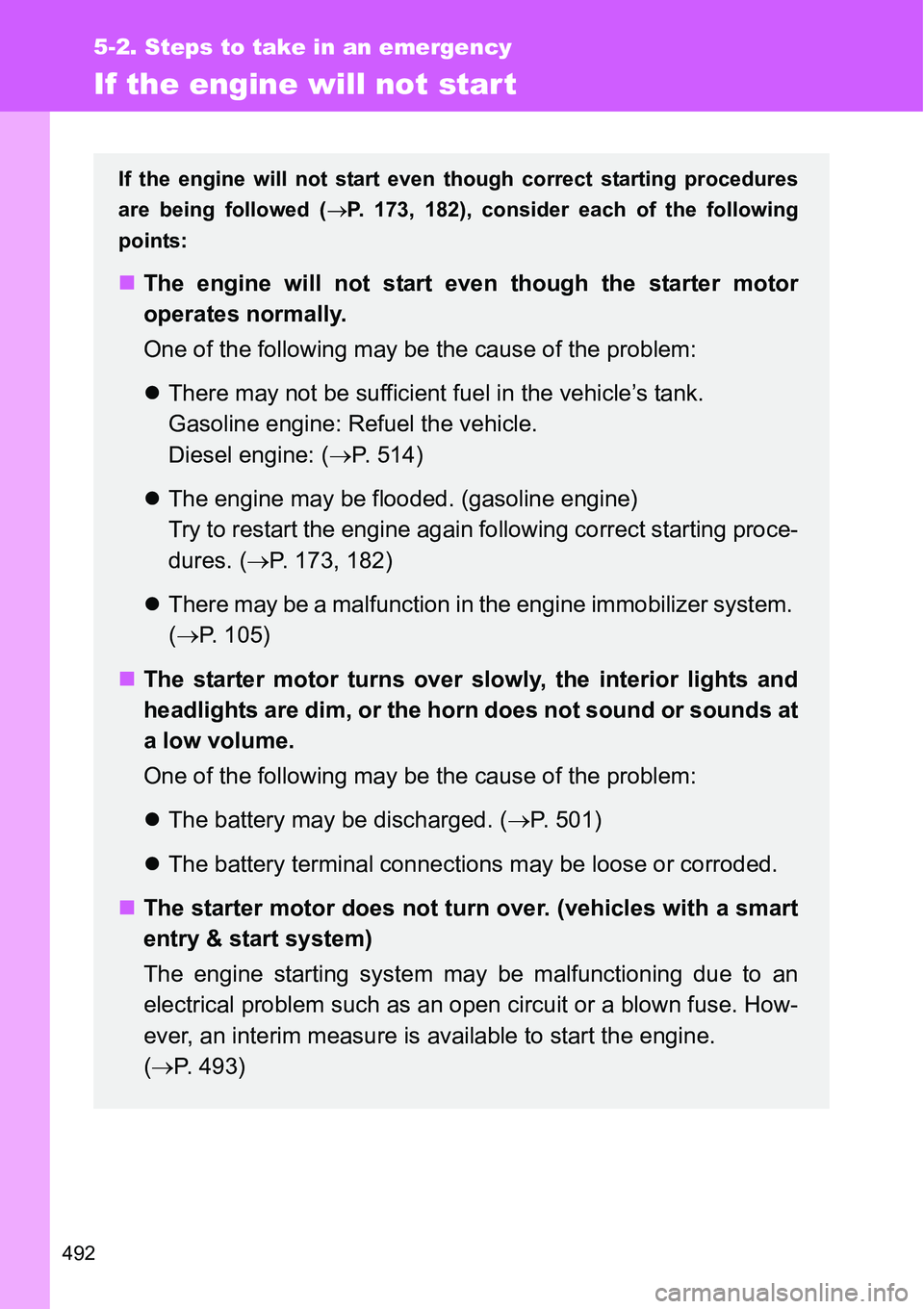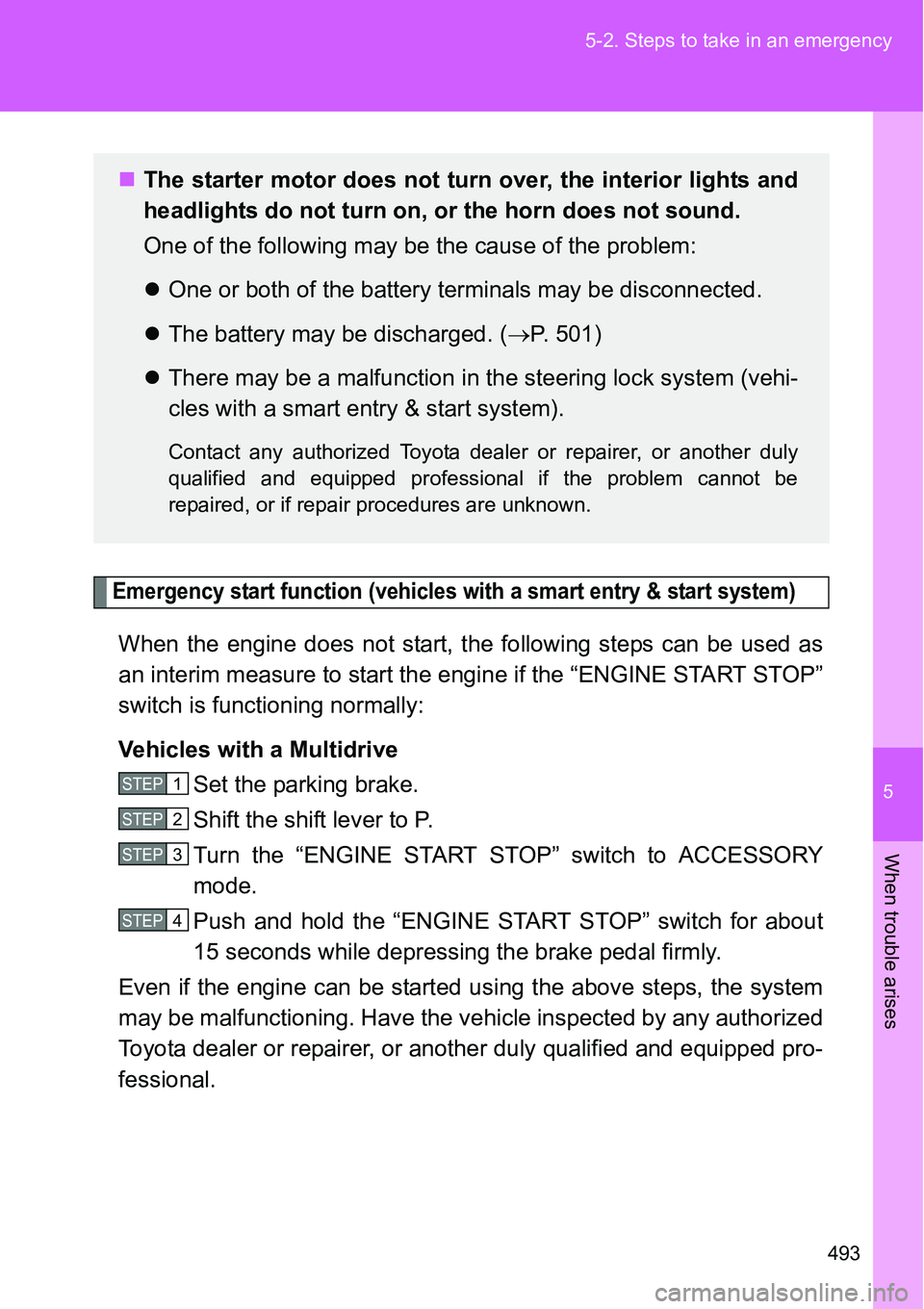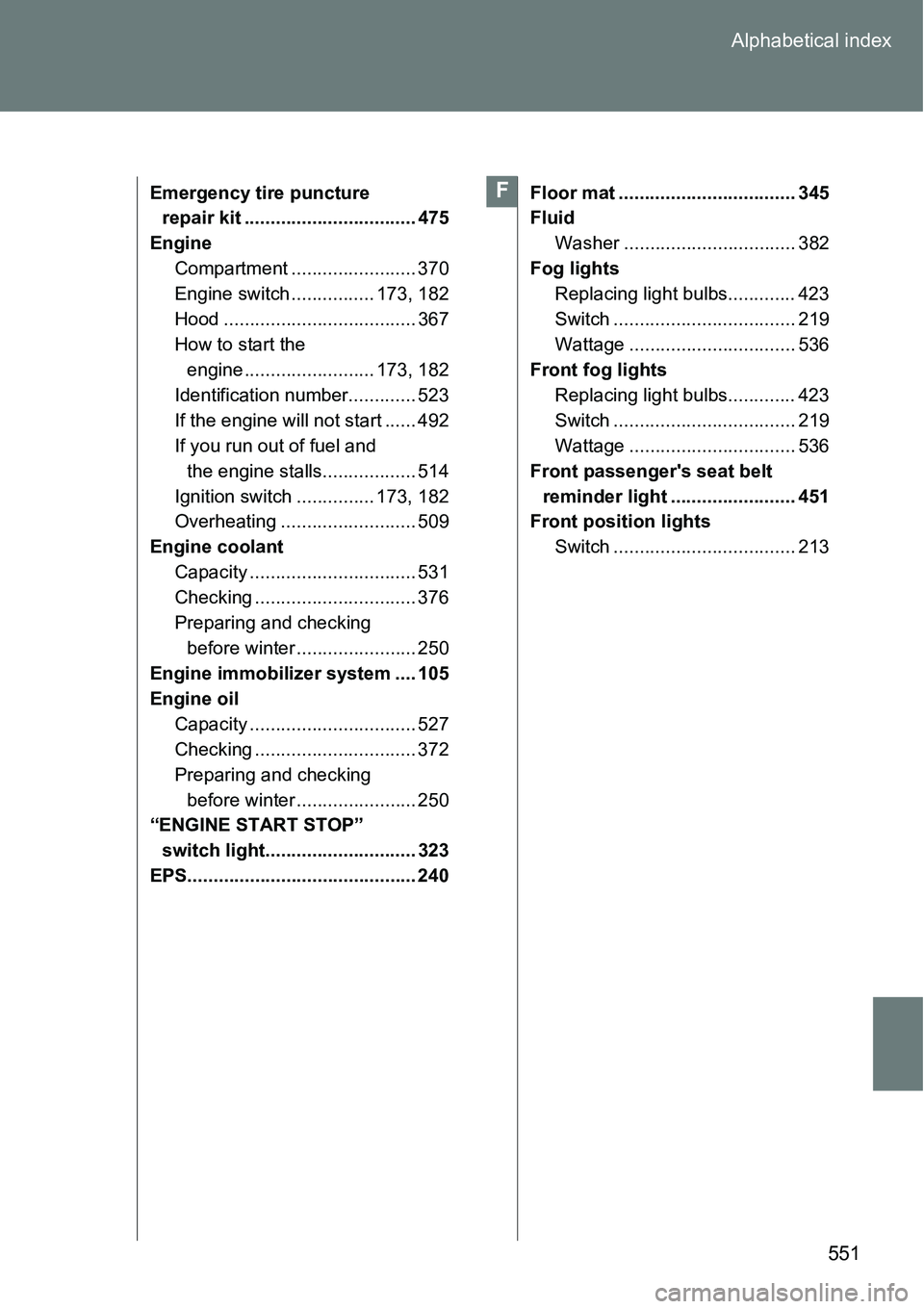Page 451 of 564
5
451 5-2. Steps to take in an emergency
When trouble arises
Low fuel level warning
light
Gasoline engine: Indi-
cates that remaining fuel is
about 5.8 L (1.5 gal., 1.3
Imp. gal.) or less.
Diesel engine: Indicates
that remaining fuel is
about 6.4 L (1.7 gal., 1.4
Imp. gal.) or less.Refuel the vehicle.
(On the instru-
ment cluster)Driver’s and front passen-
ger’s seat belt reminder
light (warning buzzer)*
3
Warns the driver and front
passenger to fasten their
seat belts.Fasten the seat belt.
(On the center
panel)Rear passengers’ seat
belt reminder lights
(warning buzzer)*
3
Warns the rear passen-
gers to fasten their seat
belts.Fasten the seat belt.
Low engine oil level warn-
ing light (diesel engine
only)
Indicates that engine oil
level is low.Check the level of engine
oil, and add if necessary.
Warning lightWarning light/DetailsCorrection procedure
Page 492 of 564

492
5-2. Steps to take in an emergency
If the engine will not start
If the engine will not start even though correct starting procedures
are being followed (P. 173, 182), consider each of the following
points:
The engine will not start even though the starter motor
operates normally.
One of the following may be the cause of the problem:
There may not be sufficient fuel in the vehicle’s tank.
Gasoline engine: Refuel the vehicle.
Diesel engine: (P. 514)
The engine may be flooded. (gasoline engine)
Try to restart the engine again following correct starting proce-
dures. (P. 173, 182)
There may be a malfunction in the engine immobilizer system.
(P. 105)
The starter motor turns over slowly, the interior lights and
headlights are dim, or the horn does not sound or sounds at
a low volume.
One of the following may be the cause of the problem:
The battery may be discharged. (P. 501)
The battery terminal connections may be loose or corroded.
The starter motor does not turn over. (vehicles with a smart
entry & start system)
The engine starting system may be malfunctioning due to an
electrical problem such as an open circuit or a blown fuse. How-
ever, an interim measure is available to start the engine.
(P. 493)
Page 493 of 564

5
493 5-2. Steps to take in an emergency
When trouble arises
Emergency start function (vehicles with a smart entry & start system)
When the engine does not start, the following steps can be used as
an interim measure to start the engine if the “ENGINE START STOP”
switch is functioning normally:
Vehicles with a Multidrive
Set the parking brake.
Shift the shift lever to P.
Turn the “ENGINE START STOP” switch to ACCESSORY
mode.
Push and hold the “ENGINE START STOP” switch for about
15 seconds while depressing the brake pedal firmly.
Even if the engine can be started using the above steps, the system
may be malfunctioning. Have the vehicle inspected by any authorized
Toyota dealer or repairer, or another duly qualified and equipped pro-
fessional.
The starter motor does not turn over, the interior lights and
headlights do not turn on, or the horn does not sound.
One of the following may be the cause of the problem:
One or both of the battery terminals may be disconnected.
The battery may be discharged. (P. 501)
There may be a malfunction in the steering lock system (vehi-
cles with a smart entry & start system).
Contact any authorized Toyota dealer or repairer, or another duly
qualified and equipped professional if the problem cannot be
repaired, or if repair procedures are unknown.
STEP1
STEP2
STEP3
STEP4
Page 505 of 564
5
505 5-2. Steps to take in an emergency
When trouble arises
Starting the engine when the battery is discharged (vehicles with a
Multidrive)
The engine cannot be started by push-starting.
To prevent battery discharge
Turn off the headlights and the audio system while the engine is off.
Turn off any unnecessary electrical components when the vehicle is run-
ning at a low speed for an extended period, such as in heavy traffic.
Charging the battery
The electricity stored in the battery will discharge gradually even when the
vehicle is not in use, due to natural discharge and the draining effects of cer-
tain electrical appliances. If the vehicle is left for a long time, the battery may
discharge, and the engine may be unable to start. (The battery recharges
automatically during driving.)
Once the engine starts, have the vehicle checked at any autho-
rized Toyota dealer or repairer, or another duly qualified and
equipped professional, as soon as possible.
Page 532 of 564
532 6-1. Specifications
Electrical system
Multidrive
The fluid capacity is the quantity of reference. If replacement is neces-
sary, contact any authorized Toyota dealer or repairer, or another duly
qualified and equipped professional.
Battery
Open voltage* at
20C (68F):12.6 12.8 V Fully charged
12.2 12.4 V Half charged
11 . 8 12.0 V Discharged
(*: Voltage checked 20 minutes after
the engine and all the lights turned
off)
Charging rates 5 A max.
Fluid capacity (Reference) 6.42 L (6.79 qt., 5.65 Imp. qt.)
Fluid type Toyota Genuine CVT FLUID FE
NOTICE
Multidrive fluid type
Using Multidrive fluid other than “Toyota Genuine CVT FLUID FE” may
cause deterioration in shift quality, locking up of your transmission accompa-
nied by vibration, and ultimately damage the transmission of your vehicle.
Page 536 of 564
536 6-1. Specifications
Light bulbs
A: HIR2 halogen bulbs B: H11 halogen bulbs
C: Wedge base bulbs (clear) D: Wedge base bulbs (amber)
E: Double end bulbs
*1: Vehicles without a panoramic roof shade
*2: Vehicles with a panoramic roof shade
Light bulbsWTy p e
ExteriorHeadlights 55 A
Front fog lights (if equipped) 55 B
Front turn signal lights 21 D
Back-up light 16 C
Rear fog light 21 C
License plate lights 5 C
Rear turn signal lights 21 D
InteriorPersonal lights
*18C
Personal/interior lights
*28C
Interior light 8 E
Luggage compartment light 5 E
Page 543 of 564
543 6-2. Customization
6
Vehicle specifications
Lights
(
P. 213)Time that the low
beam headlights
are on when the
vehicle is parked30 seconds60 seconds
—O 90 seconds
120 sec-
onds
Illumination
(
P. 323)Time elapsed
before the interior
lights turn off15 seconds7.5 seconds
—O
30 seconds
Operation when
the doors are
unlockedON OFF — O
Operation after the
engine switch is
turned OFFON OFF — O
Operation when
you approach the
vehicle with the
electronic key on
your person
*1
ON OFF — O
Footwell lighting ON OFF — O
Footwell lights
dimmer control
while drivingON OFF — O
ItemFunctionDefault set-
tingCustomized
setting
Page 551 of 564

551 Alphabetical index
Emergency tire puncture
repair kit ................................. 475
Engine
Compartment ........................ 370
Engine switch ................ 173, 182
Hood ..................................... 367
How to start the
engine ......................... 173, 182
Identification number............. 523
If the engine will not start ...... 492
If you run out of fuel and
the engine stalls.................. 514
Ignition switch ............... 173, 182
Overheating .......................... 509
Engine coolant
Capacity ................................ 531
Checking ............................... 376
Preparing and checking
before winter ....................... 250
Engine immobilizer system .... 105
Engine oil
Capacity ................................ 527
Checking ............................... 372
Preparing and checking
before winter ....................... 250
“ENGINE START STOP”
switch light............................. 323
EPS............................................ 240Floor mat .................................. 345
Fluid
Washer ................................. 382
Fog lights
Replacing light bulbs............. 423
Switch ................................... 219
Wattage ................................ 536
Front fog lights
Replacing light bulbs............. 423
Switch ................................... 219
Wattage ................................ 536
Front passenger's seat belt
reminder light ........................ 451
Front position lights
Switch ................................... 213F